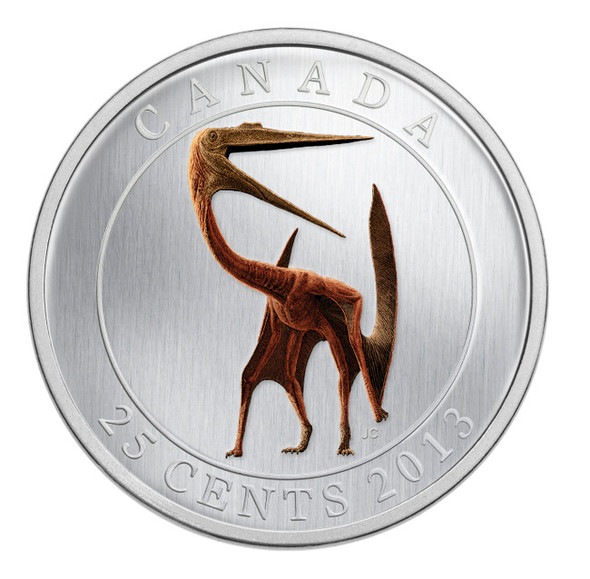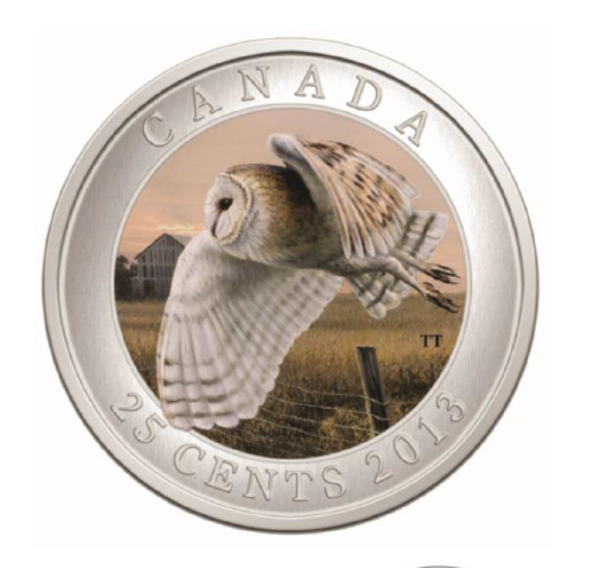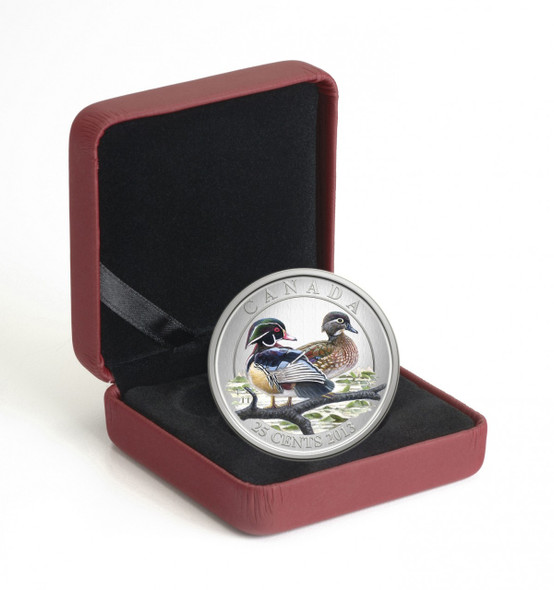Description
2013 25-CENT COLOURED COIN - PREHISTORIC ANIMALS – TYLOSAURUS PEMBINENSIS
Theme:
Millions of years ago, a vast inland sea covered the centre of the North American continent, teeming with strange and fearsome beasts. The king of these wonders was the mosasaur Tylosaurus—a superpredator related to present-day snakes and Komodo dragons that was one of the most massive creatures ever to inhabit Earth’s oceans.
Description:
This unique coloured coin includes an unusual photo-luminescent feature. Designed by Canadian artist Julius Csotonyi, with the technical guidance of paleontologists at Alberta’s Royal Tyrell Museum, the reverse side of this painted coin illustrates paleontologists’ rendition of what Tylosaurus pembinensis may have looked like. When the coin is removed from natural light, we see the skeleton upon which paleontologists have based their illustration. Centered within a raised circular frame, the daunting beast slithers across the field of the coin, head and massive jaw in the foreground, front flippers and left hind flipper extended, and massive propellant tail arched in the background. The huge mouth is open to reveal dozens of sharp, powerful teeth. In the glow-in-the-dark image, the monster is transformed into an intricate skeleton with its seemingly endless sinuous spine, complex rib structure, finger-like flipper bones, and bony tail revealed in stunning detail.
Special Features:
- This distinctive cupronickel coin is the third in this series of coloured Prehistoric Creatures coins featuring photo-luminescent elements.
- First two coins in this series sold out quickly!
- Photo-luminescence is a glow-in-the-dark technology.
- Although sunlight is best, the fluorescent and incandescent lights found in most households can also be used to activate the special photo-luminescent ink that makes the bones of the dinosaur glow. For best results, place the coin in these light sources for 30 – 60 seconds then bring it into the dark to reveal the skeleton of the dinosaur.
- The photo-luminescent (glow-in-the-dark) technology can be activated through the capsule and does not wear out.
- Designs approved by the Royal Tyrrell Museum of Palaeontology, Alberta.
- Packaged with a colourful photo-luminescent dinosaur-themed sleeve.
Product specifications:
Face Value: 25 cents
Mintage: 30,000
Composition: Cupronickel
Diameter (mm): 35
Edge: Plain
Finish: Specimen with colour Artist: Julius T. Csotonyi
Advertising Date: July 3, 2013
Launch Date: July 9, 2013
Packaging:
Coin is encapsulated and presented in a Royal Canadian Mint branded maroon clamshell case lined with black flock and protected by a customized coloured sleeve with photo-luminescent elements.
Finished size: 67 mm x 67 mm
Complete Certificate Text:
Prehistoric Terror of the Sea: Tylosaurus pembinensis
Millions of years ago, a vast inland sea covered the centre of the North American continent, from the Arctic Circle to the Gulf of Mexico. This Western Interior Seaway teemed with strange and amazing beasts. The king of these wonders was the mosasaur Tylosaurus—a superpredator that was one of the most massive creatures ever to live in the sea. This creature, which is not a dinosaur, is closely related to snakes and Komodo dragons.
Distinguished by its long, knob-like snout (Tylosaurus means “knob lizard”), this killing machine was equipped with two sets of teeth–one set in its jaw and one on its palate—and a “double-jointed” jaw that gave it an extra-large bite. It would propel its 13-metre (43-foot) body through the water with the undulations of its crescent-shaped tail and four flippers. Its massive head and teeth allowed it to devour anything in its path: sharks, fish, other mosasaurs, sea birds, and maybe the squid-like ammonites.
The first specimens of Tylosaurus were discovered by American palaeontologists Edward D. Cope and Othniel C. Marsh in the 1860s and 1870s in Kansas. A century later, palaeontologists in Manitoba unearthed the fossil of a colossal Tylosaurus-like animal that had died 80 million years ago. This specimen was the largest ever found in Canada. While this creature closely resembled Tylosaurus, some slight physical differences hinted that its exact relationship to this animal would remain the subject of scholarly discussion for some time. Then in 1988, vertebrate palaeontologist Dr. Elizabeth Nicholls of Alberta’s Royal Tyrell Museum named the creature Hainosaurus pembinensis, now renamed Tylosaurus pembinensis, for the Manitoba rock formation in which it was discovered.
This Canadian Tylosaurus, who became known around the world as “Bruce,” was approximately 13 metres (43 feet) long. Excavators were able to uncover about 70% of its original bones, making for a relatively complete skeleton. Tylosaurus “Bruce” pembinensis now resides at the Canadian Fossil Discovery Centre in Morden, Manitoba.




















